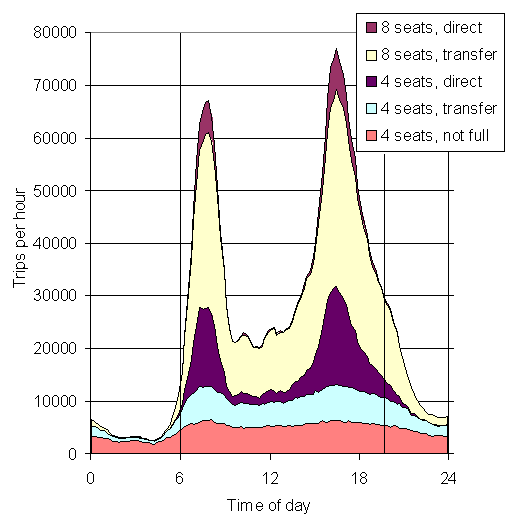Trip rate on a workday in the Helsinki metropolitan area
| Moderator:Nobody (see all) Click here to sign up. |
|
|
| Upload data
|
Contents
Scope
What is the current trip rate (# personal trips/time unit) within the Helsinki metropolitan area (Greater Helsinki) ([[en:Helsinki Metropolitan Area|HMA) from one area to another on a typical workday? This includes all modes of transportation, including private car, bus, train, tram, metro, bike, walk, and composite traffic.
Definition
The indices currently used are
- Hma_area.
- Hma_area is used as two sub-dimensions: the origin and the destination of a trip.
- Time index for time of day at 0.2 h time intervals: 0, 0.2, 0.4,... 23.8.
Data
This module calculates the trip rate for each origin-destination pair (129^2 pairs) and for each time point (12 min intervals resulting in 120 time points) based on trip data from three separate hours (morning rush, midday, afternoon rush) and time activity (based on diaries) in traffic along 24 hours.
The total number of trips equals the number of car trips in Helsinki area on a working day in 2000. All scenarios have the same street strucure and number of trips with a particular origin, destination, and time. The trips are divided into car trips and composite trips differently in each scenario based on two variables. Composite fraction is the percentage of the trips that are handled by composite traffic; the remaining trips are handled by personal cars. Guaranteed area defines the area where composite traffic is provided (i.e. the area where you are guaranteed to get a composite vehicle if you want one). The default assumption is that both the origin AND the destination must be in the guaranteed area, but it is also easy to evaluate scenarios where the guarantee covers all trips in the Helsinki area as long as either the origin OR the destination is in the guaranteed area.
The model calculates the expected number of trips for each origin-destination-time cell, and picks one random number from Poisson distributioin based on the expectation. After that, the model is deterministic all the way to Outputs node.[1]
The Helsinki Metropolitan Area Council has performed detailed trip analyses in the area. They have estimated total number of trips and the distribution between defined regions. [2] [3]
The population size and the amounts of workplaces was based on the statistics by the Helsinki Metropolitan Area Council [4]. [5]
The distribution of trips along the day is based on Expolis data[6].
The current estimate is adjusted to the total number of private car trips, and therefore it reflects only a part of the trips within the scope of this variable.
Dependencies
None defined.
Unit
# of trips per 0.2 h
Formula
The formula is defined as an Analytica model file. The computation is based on disaggregation of the total trip number according to the data described above.
Result
See also
References
- ↑ Tuomisto and Tainio: An economic way of reducing health, environmental, and other pressures of urban traffic: a decision analysis on trip aggregation. BMC Public Health 2005; 5: 123 [1].
- ↑ YTV: Helsingin seudun nykytila (The Current State of Helsinki Region) PJS B 2002:1 [2]
- ↑ YTV: Liikkumisen nykytila. Pääkaupunkiseudun julkaisusarja B 2001:10. (a report in Finnish) Figs 6, 7, 8, 9. [3]
- ↑ Seutu-CD '03. YTV (The Helsinki Metropolitan Area Council), Helsinki, 2004.
- ↑ SeutuCD 02, a CD ROM database about the Helsinki area.
- ↑ Anu Kousa, Expolis database 12.11.2002.

